Cemeteries

French Cemetery
Probably the most striking feature about the landscape of northern France is the sheer number of cemeteries that exist as well as their size. It is a very sobering experience to stop and contemplate the carnage that took place in these fields and how many young Australians never returned.
The following cemeteries are where you will probably find the greatest concentration of Australian graves but ANZAC soldiers lie buried all over Northern France. For those who are interested in specific cemeteries the best reference is probably the book by John Laffin :
Guide to Australian Battlefields of the Western Front
1916-1918 ( 3rd Edition )
ISBN 0 7318 0855 X
or the Office of Australian War Graves at :
http://www.dva.gov.au/commem/oawg/wargr.htm
World War I Cemeteries
A project commenced in 1999 to visit every cemetery from the Great War that
contained 40 or more burials, at present , over 850 have been visited and
photographed with just 45 to visit before completing our task this will be
completed in May 2005. During the travels not only have central areas such as
Ypres and the Somme been visited, but also such far flung places as Marseille,
Lyon, St. Nazaire and Strasbourg amongst many others. The only stipulation has
been that we should walk around each cemetery to pay our respects, not simply
photograph it and leave. This has been a huge task and the website is constantly
updated, currently it has over 600 files on it.
VC Corner
The VC Corner cemetery is unique amongst cemeteries of the region because it has no gravestones and contains only Australians. On the wall at the rear are the names of 1,299 Australians who died in the battle and have no known grave.
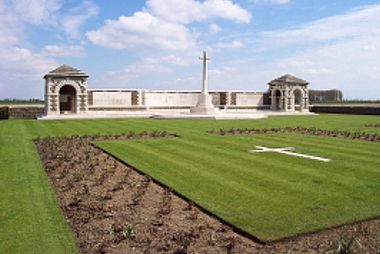
Australian VC Corner Cemetery - Fromelles
The unidentified bodies of 410 are buried in the lawns, each marked by a rose bush. The cemetery was situated in no-man's land between the Australian and German lines in 1916.
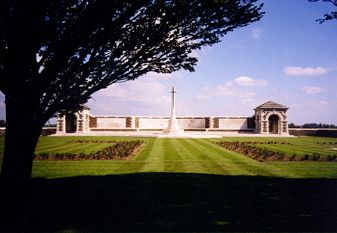
Australian VC Corner Cemetery - Fromelles
The inscription on the screen wall reads :
| "In honour of the 410 unknown Australian soldiers here buried, who were among the 1,299 Officers, Non-Commissioned Officers and Men of the Australian Imperial Force, killed in the Attack on Fromelles, July 19th and 20th, 1916." |
Losses :
Australian = 5,533 killed or wounded, 400 prisoners
British = 1,547 killed or wounded
Germans = 1,500 killed or wounded
Buttes New British
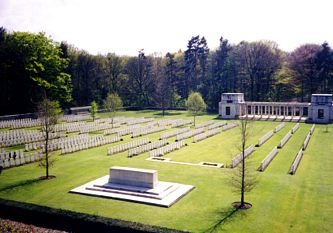
Buttes New British Cemetery with New Zealand Memorial in background
This cemetery is located in Polygon Wood, Zonnebeke. At the rear of the cemetery is the New Zealand memorial to the missing and overlooking it, on the Butte, is the Australian 5th Division Memorial.
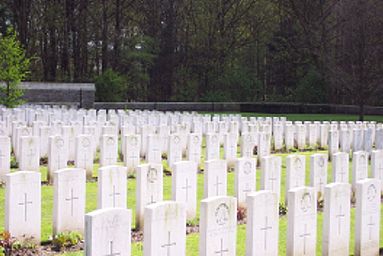
Buttes New British Cemetery
This cemetery contains 564 Australians out of a total of 2,066 graves. 407 of these graves are unnamed and they represent casualties from the surrounding battles of Menin Road, Polygon Wood, Broodseinde Ridge and Passchendaele.
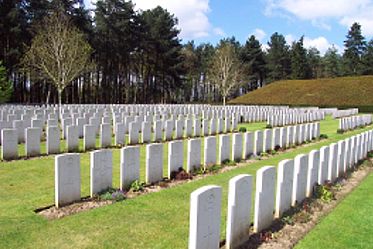
Buttes New British Cemetery
Tyne Cot
This cemetery has 11,956 graves and covers an area of 35,103 square metres. It also contains 8,366 graves of unknown soldiers. Over 1,368 Australian servicemen are buried here in the largest Commonwealth cemetery of the War.

View from atop the old Blockhouse
The blockhouse in the centre of the cemetery was captured by the Australian 3rd Division on October 4, 1917.
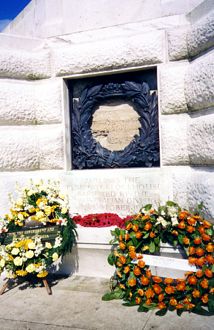
Captured Blockhouse Memorial
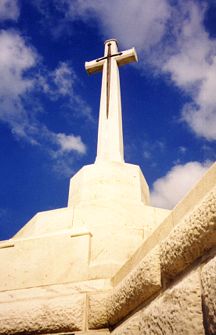
Cross of sacrifice that now stands atop old Blockhouse
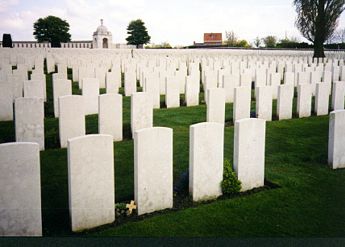
Tyne Cot Cemetery is the largest Commonwealth Cemetery of the War
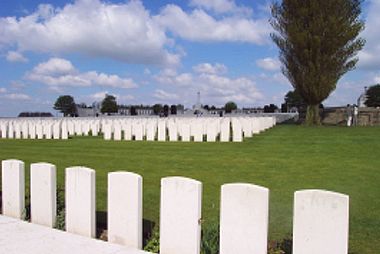
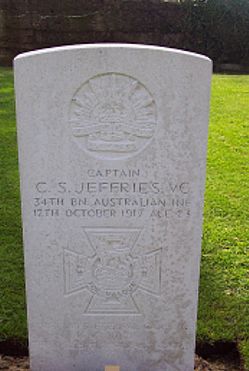
Grave of Captain Jeffries VC just behind German Blockhouse
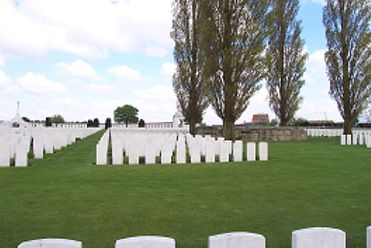
Tyne Cot Cemetery. Note German Blockhouse to left between trees
Langemark
In contrast to other Allied and Commonwealth cemeteries in the battlefields, here you will find a German one.
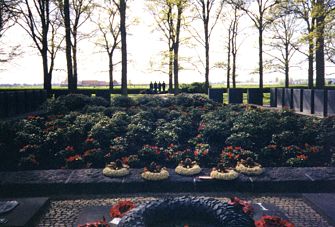
Mass grave now a rose garden
Generally, the cemetery is very dark and foreboding, in contrast to the white headstones used in Allied cemeteries, the German chose black granite. At the rear of the cemetery, directly across from the entrance, you can see four stationary shadowy figures. Silhouetted across the French countryside, these statues create a very powerful effect. Directly in front of the entrance is a large rose bed, that is in fact a mass grave. It holds between 25,000 and 30,000 Germans killed in the surrounding area. Along two sides of this garden are stone walls carrying the names of dead and missing German soldiers.
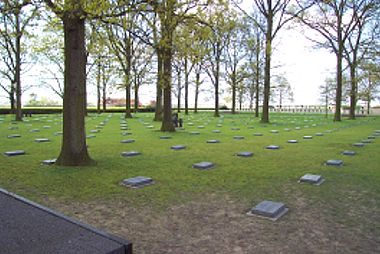
Cemetery grounds
The rest of the grounds are covered with granite headstones. Each headstone may denote the final resting place of up to a dozen men, buried in common graves. This contrasts with most Allied and Commonwealth graves where each headstone is usually the resting place of a single soldier. There are not many German cemeteries in the battlefields in general but a visit to Langemark is well worth a trip.
Villers-Bretonneux
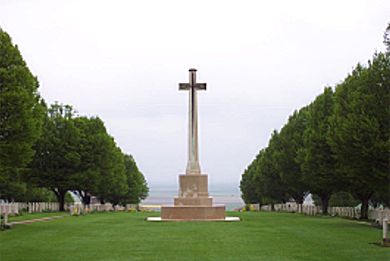
The Villers-Bretonneux cemetery contains 779 Australians, 47 of whom are unidentified. The cemetery also contains 1,089 British, 267 Canadians, 4 South Africans and 2 New Zealanders.
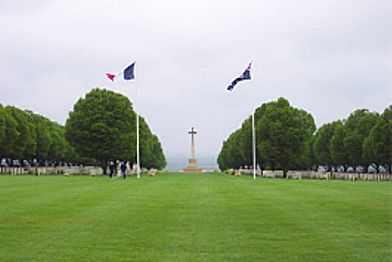
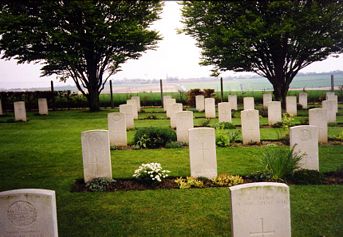
Adelaide
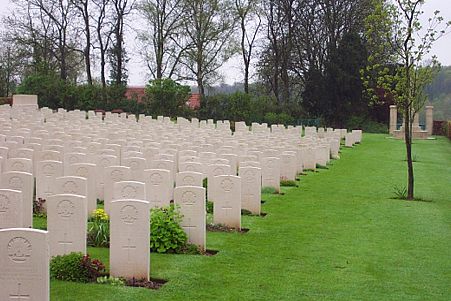
Adelaide cemetery begun June 1918 and contains 519 Australians ( 4 unknown ) out of a total of 864 graves. It is located on the right side of Amiens Road just beyond the railway crossing at the western end of Villers-Bretonneux. All here were killed between March and September 1918. The unknown soldier was exhumed in 1993 and reinterned within the Hall of Memory at the Australian War Memorial.
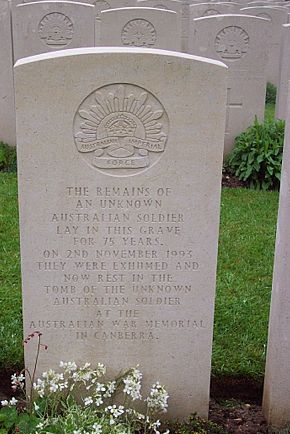
Grave of Unknown Australian Soldier now in Canberra
The inscription on the gravestone reads :
|
"The remains of an unknown Australian soldier lay in this grave for 75 years. On 2nd of November 1993 they were exhumed and now rest in the tomb of the Unknown Australian Soldier at the Australian War Memorial in Canberra" |
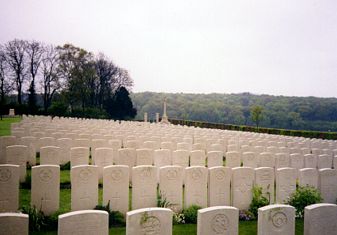
Adelaide Cemetery looking towards road
Many of Australian dead in this cemetery were killed in the street fighting in Villers-Bretonneux on Anzac Day 1918.
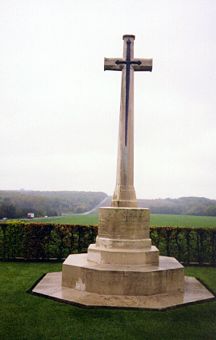
Cross of sacrifice in Adelaide Cemetery

